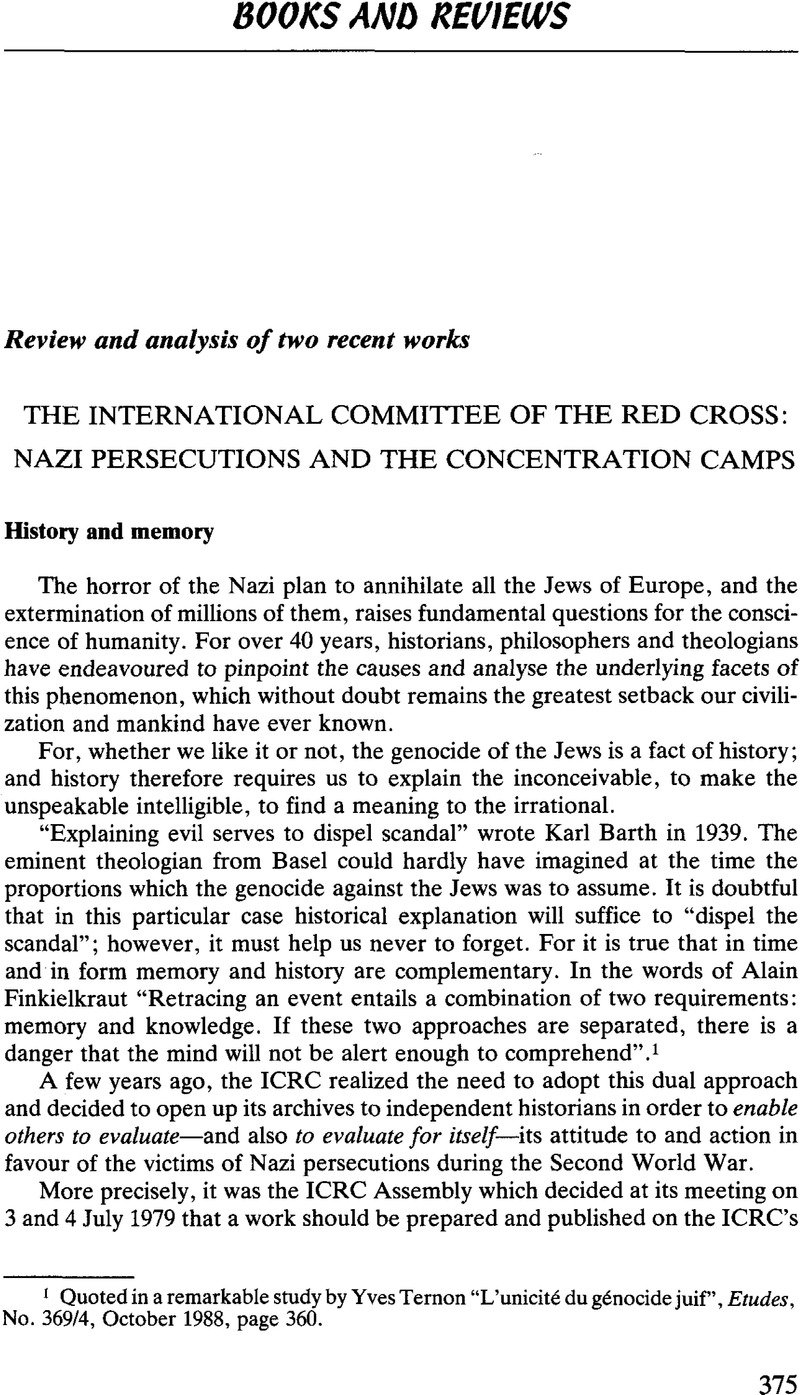Published online by Cambridge University Press: 13 January 2010

1 Quoted in a remarkable study by Yves Ternon “L'unicité du génocide juif”, Etudes, No. 369/4, 10 1988, page 360.Google Scholar
2 Among the various sources, we might mention: ICRC: Report of the ICRC on its activities during the Second World War (1 September 1939 – 30 June 1947), ICRC, Geneva, 1948, 3 vols.Google Scholar; The work of the ICRC for civilian detainees in German concentration camps (1939–1945), ICRC, Geneva, 1947 Google Scholar. Testimonies and studies include: Burckhardt, Carl J.: Meine Danziger Mission, 1937–1939, Fretz & Wasmuth Verlag, Zürich, 1960, 366 pagesGoogle Scholar; Dunand, Georges: Ne perdez pas lew trace, La Baconnière, Neuchâtel, 1950, 244 pagesGoogle Scholar; Durand, André: History of the ICRC, Vol. II, From Sarajevo to Hiroshima, Henry Dunant Institute, Geneva, 1978, 590 pagesGoogle Scholar; Junod, Marcel: Le Troisième combattant, 2nd edition, Payot, Paris, 1968 Google Scholar; Moreillon, Jacques: Le CICR et la protection des détenus politiques, Henry Dunant Institute, Geneva, L'Age d'homme, Lausanne, 1973, 303 pagesGoogle Scholar; Siordet, Frédéric: Inter arma caritas. The Work of the ICRC during the Second World War, ICRC, Geneva, 1947 Google Scholar. Other works deal partially or indirectly with the subject at issue, including the following: Arsenijevic, Drago: Otages volontaires des SS, 2nd edition, France-Empire, Paris, 1984, 365 pagesGoogle Scholar; Fleming, Gerald: Hitler et la solution finale, Julliard, Paris, 1988, 284 pagesGoogle Scholar; Laqueur, Walter: Le terrifiant secret. La «solution finale» et l'information étouffée, Gallimard, Paris, 1981, 287 pagesGoogle Scholar; Laqueur, Walter and Breitman, Richard: Breaking the silence, Simon and Schuster, New York, 1986, 320 pagesGoogle Scholar; Rings, Werner: Advokaten des Feindes: das Abenteuer der politischen Neutralität, Econ-Verlag, Vienna, 1966, 207 pagesGoogle Scholar.
3 Favez, Jean-Claude, Mission impossible? Le CICR et les camps de concentration nazis, Payot, Lausanne, 1988, 430 pagesGoogle Scholar; Ben-Tov, Arieh, Facing the Holocaust in Budapest, The International Committee of the Red Cross and the Jews in Hungary, 1943–1945, Henry Dunant Institute—Martinus Nijhoff Publishers, Geneva, Dordrecht, 1988, 492 pagesGoogle Scholar.
4 For the moment, Mr. Favez' book is only available in French and Mr. Ben-Tov's in English.
5 ICRC archives, CR 110/I–II, quoted by Favez, , op. cit., page 32 Google Scholar and by Ben-Tov, , op. cit., page 38 Google Scholar.
6 Friedländer, Saul, L'Antisémitisme nazi — Histoire d'une psychose collective, Le Seuil, Paris, 1971, page 181.Google Scholar
7 Ibid., page 191.
8 For those then in power in Germany, the “Jew remains the Enemy who wishes to dominate and destroy Germany and the whole of the non-Jewish world; Jews remain above all the infectious germ which must at all costs be identified and eliminated in order to survive”, Friedländer, S., op. cit., page 181.Google Scholar
9 “Basing ourselves on the principles adopted by the 1921 Conference for a civil war, which are thus also valid for other situations, we have concluded that it is first and foremost the task of the National Society to take care of victims of exceptional political events, including therefore political detainees. Unless national authorities request or suggest that they do so, sister Societies or an international body could intervene only if the National Society is not taking action.” Letter from Max Huber to Prince Charles of Sweden, President of the Swedish Red Cross, dated 26 09 1933 Google Scholar, quoted by Favez, , pages 52–53 Google Scholar. See also Moreillon, J., op. cit., page 62.Google Scholar
10 The “final solution” (Endlösung) was the large-scale mass extermination of European Jews by confinement in ghettos, individual brutality, mass shootings and drownings, deportation to camps and suffocation in gas chambers. It would appear that the comprehensive extermination order was issued verbally by Hitler in the spring of 1941 and the practical arrangements set at the Wannsee Conference in January 1942.
11 This refers to the decree of 7 December 1941 known under the name Nacht und Nebel, laying down most severe penalties for anyone committing offences against the Reich and prohibiting the provision of any information on the fate of arrested prisoners.
12 “One of its greatest failures in the whole story”, Ben-Tov, , op. cit., page 387.Google Scholar
13 During their unsuccessful landing at Dieppe in August 1942, Canadian commandos handcuffed German soldiers on the beach. The Reich, apparently at the highest level, ordered that over 4,000 British prisoners of war should receive the same treatment every day for 12 hours. The British retaliated by doing the same with German and Italian prisoners of war. The Reich then threatened all the prisoners it was holding. These reprisals, which prompted one of the war's most serious crises as regards application of the Geneva Conventions, carried on until November 1943 (Favez, ibid., page 139).
14 Indeed, Favez recognizes that the history of relations between Switzerland and the ICRC is still to be written.
15 “I think that this resulted in the dominance of the political stance adopted by headquarters, with the principle of neutrality in first place and the human being, no matter how great his suffering, in second place”, Ben-Tov, , op. cit., page 135.Google Scholar
16 “The ICRC's point of view”, in Favez, , op. cit., pages 376–379 Google Scholar (see below, page 394).
17 Marrou, Henri-Irénée, De la connaissance historique, Le Seuil, Paris, 1958, page 102 Google Scholar, quoted in Grosser, Alfred, L'explication historique, Armand Colin, Paris, 1972, page 23 Google Scholar.
18 The ICRC and Nazi concentration camps — The ICRC and the victims of Nazi persecutions, ICRC, Geneva, 08 1988 Google Scholar. The note was sent on 15 September 1988 to the Secretaries-General and Heads of Information Departments of National Red Cross and Red Crescent Societies